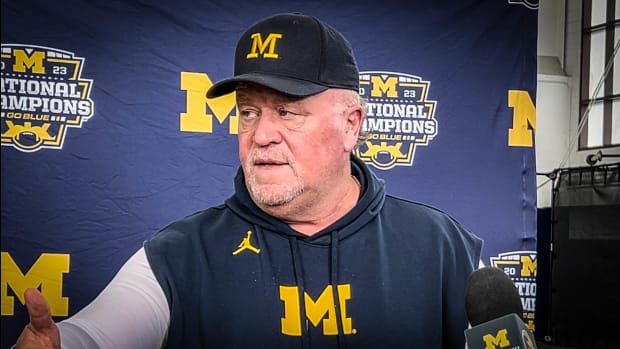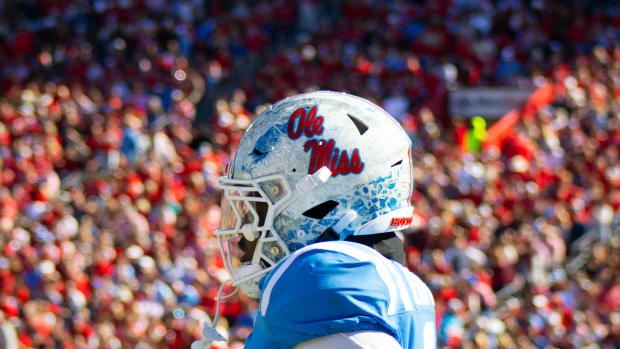Using His Alabama Lessons, Mike Locksley Already Has Maryland's Offense Humming
Welcome to Rewind Monday, where we take a closer look at one of the weekend's top storylines in college football. This week, it's Maryland's offensive start under new coach Mike Locksley after routing No. 21 Syracuse.
You have reached your limit of 4 premium articles
Register your email to get 1 more
The drives were not much longer than four hours, and Josh Jackson was never alone. His girlfriend was along for the ride. In fact, he’d stay with her family on Friday nights in Alexandria, Virginia, and then make the 25-mile commute north to College Park, Maryland, each Saturday for a daylong of football activities with his new team. He’d attend meetings before practice, watch drills from the sideline and then hang out with teammates. On Sundays, he and his girlfriend would make the drive back to Blacksburg, Virginia, to attend class. School at Virginia Tech and football at Maryland? It was a weird time. He did this at least three times last spring during the Terrapins spring practice, familiarizing himself with a new offense, new teammates and new coaches.
Maybe this at least partially explains one of Saturday’s biggest shockers on a typically wild Week 2 of college football. It’s not that Maryland beat No. 21 Syracuse, 63–20, it’s that the Terrapins carved through the Orange with an explosive, big-play offense that rolled up 650 yards and scored the most points against a ranked team in program history. There were plenty of other shocking performances over the weekend. Cal upset Washington in a game that ended at 4 a.m. ET (very on brand for the Pac-12: not only did one of its best CFP contenders lose but it all happened when most were sleeping). There was Colorado, which shocked Nebraska with a 24-point fourth quarter. There was BYU’s overtime win at Tennessee (Phillip Fulmer Watch has begun), and Army nearly stunning uninspiring Michigan. But the Terps and their high-flying offense are tough to top. This was a team nearly incapable of passing a season ago (they ranked 122nd out of 130 FBS programs), and on Saturday, they slung it all over the field, a new quarterback operating within a scheme that we’ve seen win national championships. This was Alabama’s offense.
Instead of Tua Tagovailoa rifling passes to wideouts like DeVonta Smith and Jerry Jeudy, it was Jackson zipping balls to receiver Darryl Jones and tight end Chigoziem Okonkwo (six catches for 115 yards). Instead of backs like Damien Harris and Najee Harris gashing on the ground, it was Anthony McFarland and Javon Leake (182 yards) running through seams and slipping through cracks. This was Alabama’s offense, brought to the Mid-Atlantic by former Crimson Tide coordinator Mike Locksley, in his first season as Maryland’s head coach. Even he’s a touch surprised how it’s gone so far: two games, 142 points, 7.9-yard per play average and 1,273 total yards. Oh you didn’t imagine this? “No,” Locksley laughs in an interview Saturday night with Sports Illustrated, hunkered on his couch at home and celebrating the big win by doing what any football coach would—watching more football.
How Maryland’s offense all came together to create this historic two-game stretch involves plenty of moving pieces: the implementation of Nick Saban’s strict practice regiment; late-night film sessions between Locksley and offensive coordinator Scottie Montgomery; a re-branding of schemes installed at Bama by Locksley’s predecessors there, Lane Kiffin and Brian Daboll; a plan to exploit a Syracuse defense that loaded the box; and, of course, Jackson, maybe the biggest piece of them all. His addition in June followed those spring study trips, when he digested a new RPO-heavy offense by watching dozens of clips of 2018 Alabama. He’s just like many of the millions of college football fans out there—enamored by the Tide’s skill players. “The plays those guys would make,” Jackson says. “Funny, you’d see a couple … there will be a missed assignment or a bad ball and it will turn into a touchdown. It’s just… to watch how great those guys are, Jerry Jeudy and Tua.”
But did he expect for the Terps to execute at a level of Alabama? While many around the country were astonished, Jackson was not. “We didn’t act like we were surprised,” he says bluntly. Maybe we should have expected some of this. Jackson is less than two years removed from a freshman season at Virginia Tech in which he set Hokies rookie records for TD passes and passing yards. Last year around this time, he broke his leg, had his job taken at Tech and then ultimately decided to transfer in January. The problem: In order to be immediately eligible at Maryland this year, Jackson needed to complete courses at Tech this spring to graduate in May, but he also needed to get a headstart with his new team. Thus, those road trips on I-81. “That way, when he got here in June,” Locksley says, “it wasn’t the first time he heard it all.”
It all is the offense. It is multiple, a mishmash of several different styles and schemes. Alabama’s offense is a conglomeration of schemes from its previous offensive coordinators under Saban: from Major Applewhite’s one-back set, to Jim McElwain and Doug Nussmeier’s West Coast scheme, from Kiffin and Steve Sarkisian’s spread attack to Daboll’s NFL passing portion. Saban does not allow for his offense to be overhauled by a new coordinator, only expanded and maybe tweaked. Maryland’s offense is a streamlined version. Last winter during the recruiting dead period, Locksley spent late nights teaching Montgomery the Alabama offense, the two of them in a dark film room poring over Alabama cutups and conglomerating to form the offense that’s exploded the last two weeks.
“When you take over as the playcaller at Alabama, you don’t necessarily change or streamline things, you just add to it,” Locksley says. “Some of the terminology doesn’t always make sense. I gave Scottie the ability to organize the terminology, put the verbiage down, systemize it. It was basically me teaching him what we did and him trying to organize it so he’d have the ability to call it.”
You can see Kiffin’s creative spread attacks and RPOs, the Patriots' passing scheme from Daboll and Locksley’s own offense he ran in Maryland as coordinator under Randy Edsall. It’s a medley, ingredients mixed in a bowl to make an elegant dinner. Saturday was quite the feast. The Terps entered the game expecting Syracuse to load the box to stop the run, bringing close to the line an eighth man, the safety. Maryland’s strength is its stock of running backs, a group that helped the team finish 17th nationally last season on the ground. The Orange brought that eighth man, just as Locksley and staff expected. “It enables you to run the run-pass option stuff that everybody talks about that we executed at a high level at Bama,” Locksley says. “Josh made great post-snap decisions getting the ball out to the right people. Plan was, when against the eight-man box, to utilize the RPOs and then take some play-action shots down the field.”
Through two games, Maryland has 42 plays of 10 yards or more. Only five others teams have more. The Terps have nine plays of 30 yards or more, ranking fourth nationally. The staff even utilized its stable of tailbacks in the passing game. On a few plays, Maryland played three running backs at one time, all of them lined up at receiver. “I learned from Ralph Friedgen. You get your five best skill players on the field,” Locksley says. “We’ve got four running backs that are electric playmakers in space. We created a personnel grouping where we get them on the field.”
We can talk scheme for days. We can talk personnel groupings, pass-catching running backs and big-play quarterbacks, but Locksley believes his team’s success is first rooted in practice habits (Isn’t that boring? Yes, it is, but here we go anyway). One of the foundational pillars of Saban’s success at Alabama is called “2-spotting,” the art of splitting the team into four squads (the 1s, 2s, 3s and rookies) and holding two scrimmages simultaneously on adjacent fields. Two-spotting is a way to get more reps for more players more of the time. “We’ve incorporated quite a bit of those things here,” Locksley says. “We don’t necessarily have the depth we had (at Alabama). We’ve got to be careful with the amount of reps we put on our kids.”
Jackson was introduced to that fast-moving, regimented practice structure over the summer and even more so during camp, when he won the starting job as many expected. His competition wasn’t necessarily stiff. Maryland’s recent quarterback history is not awe-inspiring—in fact, a Terps QB hasn’t thrown for 300 yards in six years. Jackson came within four yards of doing it Saturday. It’s only a matter of time. Maryland travels to Temple this coming Saturday before a well-placed bye week ahead of its first significant test: a nationally televised home game on Sept. 27, a Friday night, against Penn State. It could be a top-15 matchup. The Terps’ big win resulted in their first entrance into the AP top 25, at No. 21, since 2013. Looking back on it, Jackson is glad he made those spring trips to College Park. Things, you could say, have worked out. A laughing Jackson quips, “It was worth it.”
Have a college football question? Email it to sicollegefootball@gmail.com for a chance to have it answered in our weekly mailbag




